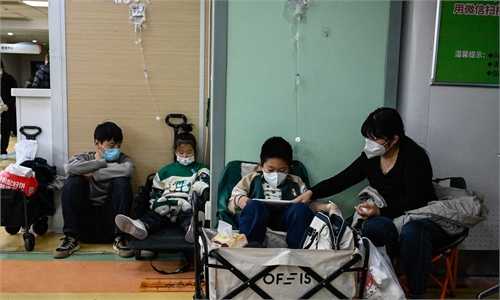
Photo: VCG
Winter brings spikes in respiratory illness in the northern hemisphere. This is common sense. This winter, respiratory illnesses are surging simultaneously in many countries. This is a fact. However some Western media professionals choose to disregard both common sense and this fact. They seem oblivious to the coughing, fever and increasing infections around them, instead pinning their eyes on China, and eagerly attempting to throw mud at it. This is a familiar pattern.
Over the past days, Western media outlets have been filled with rhetoric such as "unexplained pneumonia," "mysterious," and "concerning" when reporting on respiratory illnesses in China. It's reminiscent of the beginning of the COVID pandemic, following the same formula of associating China with mysterious pneumonia.
An article on the VOA Chinese website, entitled, "How worried should we be about the pneumonia outbreak in China," is typical in this round of smear campaign. By claiming hospitals in northern China are overwhelmed with child pneumonia cases, the article stresses this is not only a medical issue, but also a global and political issue. The entire piece is full of baseless skepticism and even conspiracy theories, speculating whether China is hiding and covering up a new virus that could "bring another disaster to the world."
The tone is simply too far away from the truth, which can be easily uncovered. Contrary to these unfounded claims, China has prioritized transparency during this flu season.
On November 23, the Chinese Health Commission held a video conference about infectious respiratory cases with WHO officials. Chinese experts briefed on the recent outbreak of respiratory illnesses in China as well as the country's efforts in monitoring pathogens, diagnosing diseases, prescribing treatment and issuing health advisories. The two sides engaged in discussions regarding epidemiology, pathology and clinical symptoms of infectious respiratory illnesses, saying they plan to keep exchanging information.
Additionally, China regularly shares its virus gene sequences with the Global Initiative on Sharing All Influenza Data (GISAID) database, Zhuang Shilihe, a Guangzhou-based medical expert who closely follows public health issues, told the Global Times.
Chinese authorities and media outlets have also been frequently upgrading the public on the trend, offering medical advice. For example, since October, there have been increasing reports and warnings about the rise of mycoplasma pneumonia in Beijing, with predictions that it may reach its peak in November.
Despite the lack of evidence to support the claim that China is hiding up a new virus, certain Western media outlets are still persisting in promoting baseless hype, politicizing, and internationalizing China's respiratory infectious diseases.
It appears that some foreign media outlets have a smearing-China key performance indicator (KPI) to complete, as they persist in writing such unreasonable articles without any valid proof, Shen Yi, a professor at Fudan University, told the Global Times.
Amid the current surge of respiratory infections in China, a term is being heatedly discussed lately - "immunity gap. On November 24, Stat News, an American health-oriented news website, ran a story with the title: "Pandemic-related immunity gap in kids explains surge of respiratory infections in children in China, says WHO."
Immunity gap means that after the lifting of COVID restrictions and control measures, non-pharmaceutical interventions (NPIs), such as school closures, travel restrictions, the use of masks in public spaces, social distancing, quarantine, are no longer in place, leading to a resurgence of transmissible infectious diseases. NPIs have been proven effective in reducing the spread of not only novel coronavirus but also many other respiratory infectious diseases, Zhuang told the Global Times.
This pattern is not exclusive to China, but applies to the world. Of course, some Western media outlets prefer to skirt around the fact that China is not the only country experiencing a surge in respiratory illnesses.
Mycoplasma pneumonia, which had previously disappeared thanks to COVID-19 measures, is making a comeback, with Switzerland recording record figures, as reported by Switzerland-based media SWI swissinfo on November 23. Reports also show that French health authorities have recently noted that emergency rooms are filled with large number of cases of atypical pneumonia among those under 15, reaching levels not seen in more than a decade. Similar reports, such as "New COVID Variant Takes Hold in the United States" and "the number of weekly flu hospital admissions continues to increase" in the US, can be found easily. If the same situation were to occur in China, it could be politicized by Western media outlets in no time.
When the US still owes the world an explanation as to why the Fort Detrick waste leak was followed by increasing lung injury cases nearby and mysterious pneumonia, it is instead busy launching hysterical political attacks against China.
According to Shen, some Western people have fallen into an abnormal hysteria toward China, coupled with the relative decline of Western governance capabilities. They systematically overlook their own country's data and situation regarding infectious diseases, but are eager to vent their sense of powerlessness and frustration by blaming and slandering China.
They have better things to do - to truly benefit their country and people - when they spread information on infectious illness which knows no borders, let facts prevail, let science guide, and let genuine medicine lead the way.


